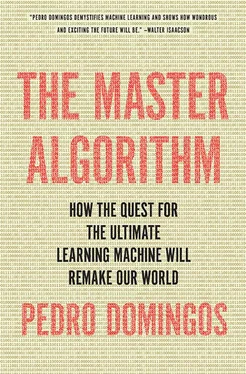Here’s an interesting experiment. Take the video stream from Robby’s eyes, treat each frame as a point in the space of images, and reduce that set of images to a single dimension. What will you discover? Time. Like a librarian arranging books on a shelf, time places each image next to its most similar ones. Perhaps our perception of it is just a natural result of our brains’ dimensionality reduction prowess. In the road network of memory, time is the main thoroughfare, and we soon find it. Time, in other words, is the principal component of memory.
The hedonistic robot
Clustering and dimensionality reduction get us closer to human learning, but there’s still something very important missing. Children don’t just passively observe the world; they do things. They pick up objects they see, play with them, run around, eat, cry, and ask questions. Even the most advanced visual system is of no use to Robby if it doesn’t help him interact with the environment. Robby needs to know not just what’s where but what to do at each moment. In principle we could teach him using step-by-step instructions, pairing sensor readings with the appropriate actions to take in response, but this is viable only for narrow tasks. The actions you take depend on your goals, not just whatever you are currently perceiving, and those goals can be far in the future. Step-by-step supervision shouldn’t be needed, in any case. Parents don’t teach their children to crawl, walk, or run; they figure it out on their own. But none of the learning algorithms we’ve seen so far can do this.
Humans do have one constant guide: their emotions. We seek pleasure and avoid pain. When you touch a hot stove, you instinctively recoil. That’s the easy part. The hard part is learning not to touch the stove in the first place. That requires moving to avoid a sharp pain that you have not yet felt. Your brain does this by associating the pain not just with the moment you touch the stove, but with the actions leading up to it. Edward Thorndike called this the law of effect: actions that lead to pleasure are more likely to be repeated in the future; actions that lead to pain, less so. Pleasure travels back through time, so to speak, and actions can eventually become associated with effects that are quite remote from them. Humans can do this kind of long-range reward seeking better than any other animal, and it’s crucial to our success. In a famous experiment, children were presented with a marshmallow and told that if they resisted eating it for a few minutes, they could have two. The ones who succeeded went on to do better in school and adult life. Perhaps less obviously, companies using machine learning to improve their websites or their business practices face a similar problem. A company may make a change that brings in more revenue in the short term-like selling an inferior product that costs less to make for the same price as the original superior product-but miss seeing that doing this will lose customers in the longer term.
The learners we saw in the previous chapters are all guided by instant gratification: every action, whether it’s flagging a spam e-mail or buying a stock, gets an immediate reward or punishment from the teacher. But there’s a whole subfield of machine learning dedicated to algorithms that explore on their own, flail, hit on rewards, and figure out how to get them again in the future, much like babies crawling around and putting things in their mouths.
It’s called reinforcement learning, and your first housebot will probably use it a lot. If you ask Robby to make eggs and bacon for you right after you’ve unpacked him and turned him on, it may take a while. But then, while you’re at work, he will explore the kitchen, noting where various things are and what kind of stove you have. By the time you get back, dinner will be ready.
An important precursor of reinforcement learning was a checkers-playing program created by Arthur Samuel, an IBM researcher, in the 1950s. Board games are a great example of a reinforcement learning problem: you have to make a long series of moves without any feedback, and the whole reward or punishment comes at the very end, in the form of a win or loss. Yet Samuel’s program was able to teach itself to play as well as most humans. It did not directly learn which move to make in each board position because that would have been too difficult. Rather, it learned how to evaluate each board position-how likely am I to win starting from this position?-and chose the move that led to the best position. Initially, the only positions it knew how to evaluate were the final ones: a win, a tie, or a loss. But once it knew that a certain position was a win, it also knew that positions from which it could move to it were good, and so on. Thomas J. Watson Sr., IBM’s president, predicted that when the program was demonstrated IBM stock would go up by fifteen points. It did. The lesson was not lost on IBM, which went on to build a chess champion and a Jeopardy! one.
The notion that not all states have rewards (positive or negative) but every state has a value is central to reinforcement learning. In board games, only final positions have a reward (1, 0, or −1 for a win, tie, or loss, say). Other positions give no immediate reward, but they have value in that they can lead to rewards later. A chess position from which you can force checkmate in some number of moves is practically as good as a win and therefore has high value. We can propagate this kind of reasoning all the way to good and bad opening moves, even if at that distance the connection is far from obvious. In video games, the rewards are usually points, and the value of a state is the number of points you can accumulate starting from that state. In real life, a reward now is better than a reward later, so future rewards can be discounted by some rate of return, like investments. Of course, the rewards depend on what actions you choose, and the goal of reinforcement learning is to always choose the action that leads to the greatest rewards. Should you pick up the phone and ask your friend for a date? It could be the start of a beautiful relationship or just the route to a painful rejection. Even if your friend agrees to go on a date, that date may turn out well or not. Somehow, you have to abstract over all the infinite paths the future could take and make a decision now. Reinforcement learning does that by estimating the value of each state-the sum total of the rewards you can expect to get starting from that state-and choosing the actions that maximize it.
Suppose you’re moving along a tunnel, Indiana Jones-like, and you come to a fork. Your map says the left tunnel leads to a treasure and the right one to a snake pit. The value of where you’re standing-right before the fork-is the value of the treasure because you’ll choose to go left. If you always choose the best possible action, then the value of a state differs from the value of the succeeding state only by the immediate reward (if any) that you’ll get by performing that action. If we know each state’s immediate reward, we can use this observation to update the values of neighboring states, and so on, until all states have consistent values. The treasure’s value propagates backward along the tunnel until it reaches the fork and beyond. Once you know the value of each state, you also know which action to choose in each state (the one that maximizes the combination of immediate reward and value of the resulting state). This much was worked out in the 1950s by the control theorist Richard Bellman. But the real problem in reinforcement learning is when you don’t have a map of the territory. Then your only choice is to explore and discover what rewards are where. Sometimes you’ll discover a treasure, and other times you’ll fall into a snake pit. Every time you take an action, you note the immediate reward and the resulting state. That much could be done by supervised learning. But you also update the value of the state you just came from to bring it into line with the value you just observed, namely the reward you got plus the value of the new state you’re in. Of course, that value may not yet be the correct one, but if you wander around doing this for long enough, you’ll eventually settle on the right values for all the states and the corresponding actions. That’s reinforcement learning in a nutshell.
Читать дальше












